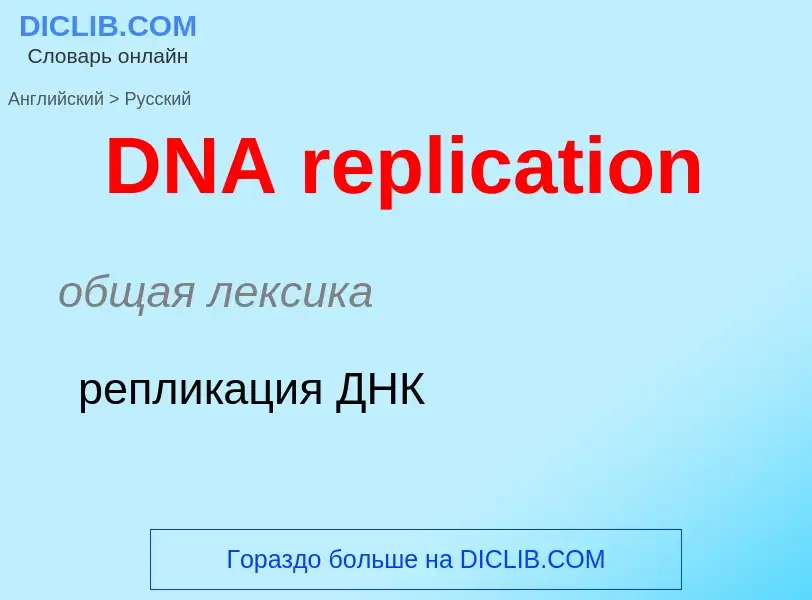Tradução e análise de palavras por inteligência artificial ChatGPT
Nesta página você pode obter uma análise detalhada de uma palavra ou frase, produzida usando a melhor tecnologia de inteligência artificial até o momento:
- como a palavra é usada
- frequência de uso
- é usado com mais frequência na fala oral ou escrita
- opções de tradução de palavras
- exemplos de uso (várias frases com tradução)
- etimologia
DNA replication - tradução para russo
общая лексика
репликация ДНК
общая лексика
репликатор
начало репликации
Wikipédia
In molecular biology, DNA replication is the biological process of producing two identical replicas of DNA from one original DNA molecule. DNA replication occurs in all living organisms acting as the most essential part of biological inheritance. This is essential for cell division during growth and repair of damaged tissues, while it also ensures that each of the new cells receives its own copy of the DNA. The cell possesses the distinctive property of division, which makes replication of DNA essential.
DNA is made up of a double helix of two complementary strands. The double helix describes the appearance of a double-stranded DNA which is thus composed of two linear strands that run opposite to each other and twist together to form. During replication, these strands are separated. Each strand of the original DNA molecule then serves as a template for the production of its counterpart, a process referred to as semiconservative replication. As a result of semi-conservative replication, the new helix will be composed of an original DNA strand as well as a newly synthesized strand. Cellular proofreading and error-checking mechanisms ensure near perfect fidelity for DNA replication.
In a cell, DNA replication begins at specific locations, or origins of replication, in the genome which contains the genetic material of an organism. Unwinding of DNA at the origin and synthesis of new strands, accommodated by an enzyme known as helicase, results in replication forks growing bi-directionally from the origin. A number of proteins are associated with the replication fork to help in the initiation and continuation of DNA synthesis. Most prominently, DNA polymerase synthesizes the new strands by adding nucleotides that complement each (template) strand. DNA replication occurs during the S-stage of interphase.
DNA replication (DNA amplification) can also be performed in vitro (artificially, outside a cell). DNA polymerases isolated from cells and artificial DNA primers can be used to start DNA synthesis at known sequences in a template DNA molecule. Polymerase chain reaction (PCR), ligase chain reaction (LCR), and transcription-mediated amplification (TMA) are examples. In March 2021, researchers reported evidence suggesting that a preliminary form of transfer RNA, a necessary component of translation, the biological synthesis of new proteins in accordance with the genetic code, could have been a replicator molecule itself in the very early development of life, or abiogenesis.

![trimer]] of the protein [[PCNA]]. trimer]] of the protein [[PCNA]].](https://commons.wikimedia.org/wiki/Special:FilePath/1axc tricolor.png?width=200)
![element]] and the detailed structures of two [[base pair]]s are shown in the bottom right. element]] and the detailed structures of two [[base pair]]s are shown in the bottom right.](https://commons.wikimedia.org/wiki/Special:FilePath/DNA Structure+Key+Labelled.pn NoBB.png?width=200)






![Genome of ''[[human herpesvirus-6]]'', a member of the [[Herpesviridae]] family. The origin of replication is labeled as "OOR." Genome of ''[[human herpesvirus-6]]'', a member of the [[Herpesviridae]] family. The origin of replication is labeled as "OOR."](https://commons.wikimedia.org/wiki/Special:FilePath/Hhv6 genome2.png?width=200)
![Replication cycle of a [[coronavirus]] (class 4) Replication cycle of a [[coronavirus]] (class 4)](https://commons.wikimedia.org/wiki/Special:FilePath/Coronavirus replication.png?width=200)

